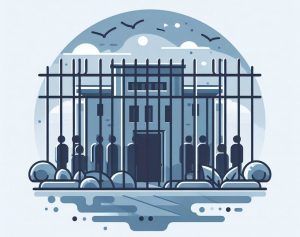Davi Málaga (2024)
This blogpost reflects part of Davi Mendes Málaga’s Ph.D. research on the field of Administration, with focus in Public Administration and Policy. In this work, this scholar is currently studying imprisonment and incarceration through a public policy standpoint, the different traditions in prison policy, as well as the way that policy choices affect the policy results regarding imprisonment, sentencing, criminalization and other important factors for social life.
By Davi Málaga
Norway’s prison policy is widely regarded as an example of high standards of treatment and respect for human rights and is often considered part of a phenomenon some scholars call scandinavian exceptionalism (Crewe et al., 2022; Pratt, 2007). However, no matter how organized and shiny Norwegian prisons are, they are still prisons: institutions serving the purpose of social control, restraining the freedom of people who do not conform to the law to protect the wider society.
We conducted an in-depth study of Norwegian imprisonment policy, on which we analyzed the way the prison policy is implemented at Bergen Prison through a Case Study. We spoke with people who fulfilled different roles among prison staff, to get a better understanding of the prison, how it works, their routines, social relationships in the workplace, thoughts about the prison, and daily challenges.
Inside Bergen Prison, we saw pristine conditions. Individual rooms for each inmate, a well-equipped grocery store, educational programs, and professionals well-prepared to deal with issues ranging from drug abuse to sexual offenses and anger management. Efforts to connect with the inmates are considered measures towards building a more humane prison system, measures at which Bergen Prison excels.
All officers undergo a three-year program at the University College of Norwegian Correctional Service (KRUS), where they learn to restrain and subdue a temporarily violent person, but also dynamic security, the art of socially connecting with the inmates to build a community based on respect. This builds on the principle that inmates are less likely to hurt or attack someone who treats them well and whom they respect (United Nations Office on Drugs and Crime, 2015). In our study, we found that inmates are given broad support, in compliance with the guidelines established by the Norwegian Correctional Service (Kriminalomsorgen – literally “criminality-care”).
However, a closer examination reveals contradictions, leaving the Norwegian prison system looking less polished, and demystifying the exceptionality that surrounds it when viewed from outside Scandinavia. Not only are there cracks in the system, but they are widening, as prisons’ budgets are squeezed by annual “efficiency cuts”, and parliamentary decisions limit spending discretion.
In addition to the economic stressors eroding conditions for the current imprisonment policy, there are contradictions inherent in the policy. While Kriminalomsorgen’s institutional strategy defines resocialization as the goal, a significant share of those incarcerated come back after release – around 20% according to national statistics. And while Norway does not impose life sentences, some are convicted to indefinite imprisonment (sikring), where sentences are extended every five years, and release may be unlikely.
There are plenty of support for inmates to learn a trade, finish their education, or get a college degree. But while such programs, aimed at resocialization, are well suited to some inmates, such as the young and economically active, they may be less beneficial for the elderly or mentally ill. Resocialization requires people to think about the future they want for themselves, which is hard for people who cannot see a way forward or feel that they have little time left.
In practice, the resocialization policy is difficult to distinguish from compliance. The inmates who can be “saved” are given a social and economic purpose; the rest are removed from society on a semi-permanent basis to prevent future crimes. Such measures, disposing of people in a humane way, are arguably necessary, but still tragic, as they represent the society giving up on some of its own.
Despite excellent material conditions compared to prisons in most other countries, Norwegian prisons are still products of public policies attempting to solve social problems through incarceration. They remain a Sword of Damocles, hanging by a single horse’s hair over the head of each person in Norway, potentially snapping from a single lack of judgment or bad decision made in the course of everyday life.
This doesn’t mean that the current imprisonment policy shouldn’t be protected! Despite challenges, it continues to reflect the progress made through political struggles in the 70s, that made Norwegian state-of-the-art prisons acknowledged throughout the world as a model to emulate. This will soon be lost if nothing is done to prevent the erosion of the system by politicians failing to pass budgets that can sustain the prison system in its current form.
References:
Crewe, B., Ievins, A., Larmour, S., Laursen, J., Mjaland, K., & Schliehe, A. (2022). Nordic penal exceptionalism: A comparative, empirical analysis. BRITISH JOURNAL OF CRIMINOLOGY, XX, 1–20. https://doi.org/10.1093/bjc/azac013
Pratt, J. (2007). Scandinavian Exceptionalism in an Era of Penal Excess: Part I: The Nature and Roots of Scandinavian Exceptionalism. British Journal of Criminology, 48(2), 119–137. https://doi.org/10.1093/bjc/azm072
United Nations Office on Drugs and Crime. (2015). Handbook on Dynamic Security and Prison Intelligence. United Nations.

